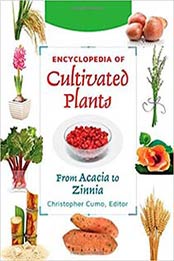
Encyclopedia of Cultivated Plants [3 volumes]: From Acacia to Zinnia by Christopher Martin Cumo
Print Length: 1236 Pages
Publisher: ABC-CLIO
Publication Date: April 25, 2013
Language: English
ASIN: B00ODJN5BU
ISBN-10: 1598847740
ISBN-13: 978-1598847741
File Format: PDF
Readers of this expansive, three-volume encyclopedia will gain scientific, sociological, and demographic insight into the complex relationship between plants and humans across history.
Reviews
This encyclopedia contains a small sample of cultivated plants—the editor has chosen 282 plants to represent the estimated 35,000 cultivated plants from around the world. Of the 150 species cultivated for human and animal food, 30 provide 95 percent of the calories and protein eaten, and these 30 are included in this work. The rest of the entries are an eclectic collection of foods, flavorings, ornamental plants, pharmacological plants, landscape and commercial trees, shrubs, and grasses. The food group includes nuts, vegetables, fruits, herbs, spices, and grains. Examples of entries include Cannabis, Cotton, Flax, Raffia, and Teff. Entries average two to three pages and provide a history and trivia of each plant. The entry on cannabis, for example, provides an detailed history of its origins and long use as a food and a fiber as well as a drug. Each entry has at least two suggestions for further reading. A list of some organizations dedicated to plants, especially cultivated ones, precedes a selected bibliography of books about plants. Users will find the detailed index points to people, cultures, and locations. A “Guide to Related Topics” offers 23 related groups, including a nonplant entry—an interesting history of botanical illustration. Although not an encyclopedic summary of the knowledge about cultivated plants, this set does contain clearly written information about plants and plant groups. It would be a more useful subject encyclopedia had it been limited to the 150 important, cultivated food species or narrowed to a specific group of ornamentals or a wide selection of cultivated grasses, and so forth. The fact that it is a sample rather than a specific encyclopedia, even with its good information, limits its value. An optional purchase for most public and academic libraries. –Linda Scarth
![Guide to Wild Foods and Useful Plants by Christopher Nyerges [EPUB: 1613746989] Guide to Wild Foods and Useful Plants by Christopher Nyerges](https://cookebooks.info/wp-content/uploads/2020/04/1613746989.jpg)
![Foraging by Mona Greeny [PDF: B08HN7SW4F] Foraging by Mona Greeny [PDF: B08HN7SW4F]](https://cookebooks.info/wp-content/uploads/2022/01/B08HN7SW4F.jpg)
![Kuckunniw Fields Guide to Edible Wild Plants by Philip Kuckunniw [PDF: 9798663745703] Kuckunniw Fields Guide to Edible Wild Plants by Philip Kuckunniw](https://cookebooks.info/wp-content/uploads/2020/07/9798663745703.jpg)
![The Healing Power of Plants by Fran Bailey [EPUB: 1529104068] The Healing Power of Plants by Fran Bailey](https://cookebooks.info/wp-content/uploads/2019/08/1529104068.jpg)
![Wildcrafted Fermentation by Pascal Baudar [EPUB: 1603588515] Wildcrafted Fermentation by Pascal Baudar](https://cookebooks.info/wp-content/uploads/2020/03/1603588515.jpg)
![Foraging Wild Edible Plants of North America by Christopher Nyerges [EPUB: 1493064479] Foraging Wild Edible Plants of North America by Christopher Nyerges [EPUB: 1493064479]](https://cookebooks.info/wp-content/uploads/2023/05/1493064479-170x261.jpg)